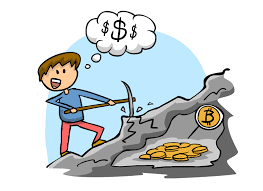What is Bitcoin?
Bitcoin is a global payment system for cryptocurrency and
digital payment system called the first decentralized digital currency, since
the system operates without a central repository or a single administrator. It
was invented by an unknown programmer or a group of programmers, under the name
Satoshi Nakamoto and released as open source software in 2009. The system is
peer-to-peer, and transactions take place directly among users, without an
intermediary. These transactions are verified by network nodes and recorded in
a public register called blockchain. Bitcoins are created as a reward for
mining. They can be exchanged for other currencies, products and services. In
February 2015, more than 100,000 merchants and sellers accept Bitcoin as
payment. Bitcoin can also be maintained as an investment. According to research
produced by the University of Cambridge in 2017, there are 2.9 to 5.8 million
unique users who use a portfolio of cryptocurrency, most of which are bitcoins.
What is blockchain?
The blockchain is a public record that records bitcoin transactions. A new solution accomplishes this without any central trusted authority: maintenance of the lock chain is done through a network of communication nodes that execute the bitcoin software. Transactions X of the Pay form send the Y-bitcoins to the Z beneficiary are transmitted to this network using readily available software applications. Network nodes can validate transactions, add them to their copy of the general ledger, and distribute these general ledger additions to other nodes. The block string is a distributed database - to obtain an independent verification of the ownership chain of any bitcoin, each network node stores its own copy of the blocking string. About six times per hour, a new group of accepted transactions is created, a block, added to the string of blocks and published quickly to all nodes. This allows the bitcoin software to determine when a certain amount of bitcoin has been spent, which is necessary to avoid double expenditure in an unattended central environment. Although an ordinary registry records transfers of actual bills or promissory notes that exist outside of it, the block chain is the only place where you can say that bitcoins exist as outlets for unspent transactions .
Transactions
Transactions are defined using a Forth script language. A
valid transaction must have one or more entries. Each entry must be an unused output from a
previous transaction. The transaction must bear the digital signature of each
owner of the entry. The use of multiple entries refers to the use of multiple
currencies in a cash transaction. A transaction can also have multiple exits,
allowing you to make multiple payments at the same time. A transaction output
can be specified as an arbitrary multiple of satoshi. As in a cash transaction,
the sum of inputs (coins used to pay) may exceed the expected amount of
payments. In this case, an additional output is used, returning the change to
the payer. Any entry of satoshis not recorded in the transaction balances
becomes the transaction fee.
Mining
Mining is a record keeping service through the use of
computer processing power. Miners keep
the block chain consistent, complete and unalterable by repeatedly checking and
collecting new broadcast transactions in a new block group. Each block contains
a cryptographic hash of the previous block, using the hash algorithm SHA-256, linking
it to the previous block, thus giving the block string its name.
"All the images are taken from google"





No comments:
Post a Comment